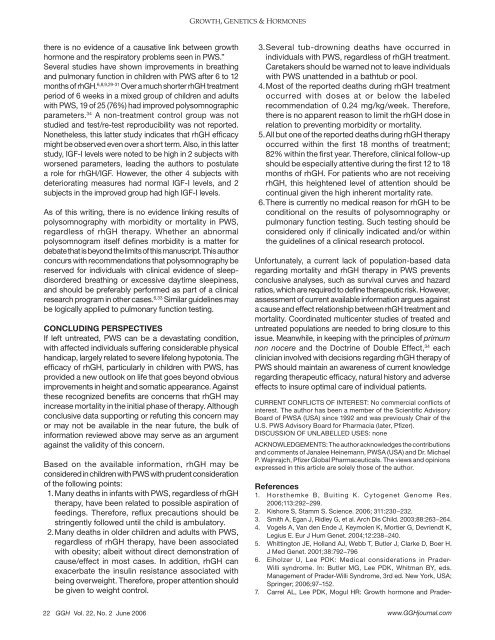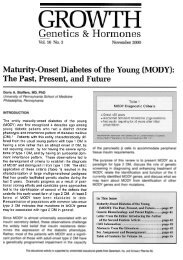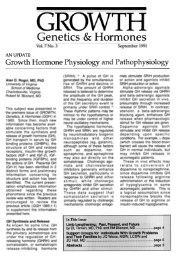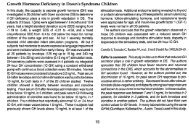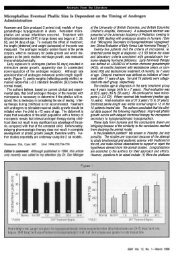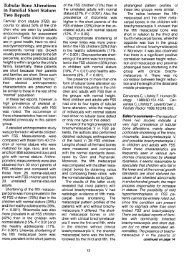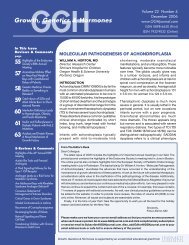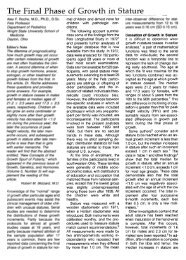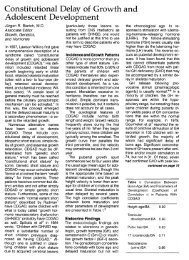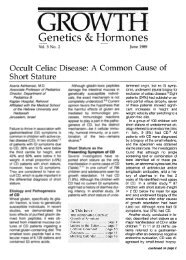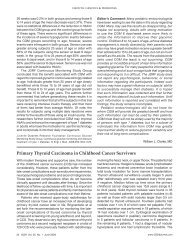Download pdf of current issue - GGH Journal
Download pdf of current issue - GGH Journal
Download pdf of current issue - GGH Journal
Create successful ePaper yourself
Turn your PDF publications into a flip-book with our unique Google optimized e-Paper software.
GROWTH, GENETICS & HORMONES<br />
there is no evidence <strong>of</strong> a causative link between growth<br />
hormone and the respiratory problems seen in PWS.”<br />
Several studies have shown improvements in breathing<br />
and pulmonary function in children with PWS after 6 to 12<br />
months <strong>of</strong> rhGH. 6,8,9,29-31 Over a much shorter rhGH treatment<br />
period <strong>of</strong> 6 weeks in a mixed group <strong>of</strong> children and adults<br />
with PWS, 19 <strong>of</strong> 25 (76%) had improved polysomnographic<br />
parameters. 34 A non-treatment control group was not<br />
studied and test/re-test reproducibility was not reported.<br />
Nonetheless, this latter study indicates that rhGH efficacy<br />
might be observed even over a short term. Also, in this latter<br />
study, IGF-I levels were noted to be high in 2 subjects with<br />
worsened parameters, leading the authors to postulate<br />
a role for rhGH/IGF. However, the other 4 subjects with<br />
deteriorating measures had normal IGF-I levels, and 2<br />
subjects in the improved group had high IGF-I levels.<br />
As <strong>of</strong> this writing, there is no evidence linking results <strong>of</strong><br />
polysomnography with morbidity or mortality in PWS,<br />
regardless <strong>of</strong> rhGH therapy. Whether an abnormal<br />
polysomnogram itself defines morbidity is a matter for<br />
debate that is beyond the limits <strong>of</strong> this manuscript. This author<br />
concurs with recommendations that polysomnography be<br />
reserved for individuals with clinical evidence <strong>of</strong> sleepdisordered<br />
breathing or excessive daytime sleepiness,<br />
and should be preferably performed as part <strong>of</strong> a clinical<br />
research program in other cases. 6,33 Similar guidelines may<br />
be logically applied to pulmonary function testing.<br />
CONCLUDING PERSPECTIVES<br />
If left untreated, PWS can be a devastating condition,<br />
with affected individuals suffering considerable physical<br />
handicap, largely related to severe lifelong hypotonia. The<br />
efficacy <strong>of</strong> rhGH, particularly in children with PWS, has<br />
provided a new outlook on life that goes beyond obvious<br />
improvements in height and somatic appearance. Against<br />
these recognized benefits are concerns that rhGH may<br />
increase mortality in the initial phase <strong>of</strong> therapy. Although<br />
conclusive data supporting or refuting this concern may<br />
or may not be available in the near future, the bulk <strong>of</strong><br />
information reviewed above may serve as an argument<br />
against the validity <strong>of</strong> this concern.<br />
Based on the available information, rhGH may be<br />
considered in children with PWS with prudent consideration<br />
<strong>of</strong> the following points:<br />
1. Many deaths in infants with PWS, regardless <strong>of</strong> rhGH<br />
therapy, have been related to possible aspiration <strong>of</strong><br />
feedings. Therefore, reflux precautions should be<br />
stringently followed until the child is ambulatory.<br />
2. Many deaths in older children and adults with PWS,<br />
regardless <strong>of</strong> rhGH therapy, have been associated<br />
with obesity; albeit without direct demonstration <strong>of</strong><br />
cause/effect in most cases. In addition, rhGH can<br />
exacerbate the insulin resistance associated with<br />
being overweight. Therefore, proper attention should<br />
be given to weight control.<br />
3. Several tub-drowning deaths have occurred in<br />
individuals with PWS, regardless <strong>of</strong> rhGH treatment.<br />
Caretakers should be warned not to leave individuals<br />
with PWS unattended in a bathtub or pool.<br />
4. Most <strong>of</strong> the reported deaths during rhGH treatment<br />
occurred with doses at or below the labeled<br />
recommendation <strong>of</strong> 0.24 mg/kg/week. Therefore,<br />
there is no apparent reason to limit the rhGH dose in<br />
relation to preventing morbidity or mortality.<br />
5. All but one <strong>of</strong> the reported deaths during rhGH therapy<br />
occurred within the first 18 months <strong>of</strong> treatment;<br />
82% within the first year. Therefore, clinical follow-up<br />
should be especially attentive during the first 12 to 18<br />
months <strong>of</strong> rhGH. For patients who are not receiving<br />
rhGH, this heightened level <strong>of</strong> attention should be<br />
continual given the high inherent mortality rate.<br />
6. There is <strong>current</strong>ly no medical reason for rhGH to be<br />
conditional on the results <strong>of</strong> polysomnography or<br />
pulmonary function testing. Such testing should be<br />
considered only if clinically indicated and/or within<br />
the guidelines <strong>of</strong> a clinical research protocol.<br />
Unfortunately, a <strong>current</strong> lack <strong>of</strong> population-based data<br />
regarding mortality and rhGH therapy in PWS prevents<br />
conclusive analyses, such as survival curves and hazard<br />
ratios, which are required to define therapeutic risk. However,<br />
assessment <strong>of</strong> <strong>current</strong> available information argues against<br />
a cause and effect relationship between rhGH treatment and<br />
mortality. Coordinated multicenter studies <strong>of</strong> treated and<br />
untreated populations are needed to bring closure to this<br />
<strong>issue</strong>. Meanwhile, in keeping with the principles <strong>of</strong> primum<br />
non nocere and the Doctrine <strong>of</strong> Double Effect, 34 each<br />
clinician involved with decisions regarding rhGH therapy <strong>of</strong><br />
PWS should maintain an awareness <strong>of</strong> <strong>current</strong> knowledge<br />
regarding therapeutic efficacy, natural history and adverse<br />
effects to insure optimal care <strong>of</strong> individual patients.<br />
CURRENT CONFLICTS OF INTEREST: No commercial conflicts <strong>of</strong><br />
interest. The author has been a member <strong>of</strong> the Scientific Advisory<br />
Board <strong>of</strong> PWSA (USA) since 1992 and was previously Chair <strong>of</strong> the<br />
U.S. PWS Advisory Board for Pharmacia (later, Pfizer).<br />
DISCUSSION OF UNLABELLED USES: none<br />
ACKNOWLEDGEMENTS: The author acknowledges the contributions<br />
and comments <strong>of</strong> Janalee Heinemann, PWSA (USA) and Dr. Michael<br />
P. Wajnrajch, Pfizer Global Pharmaceuticals. The views and opinions<br />
expressed in this article are solely those <strong>of</strong> the author.<br />
References<br />
1. Horsthemke B, Buiting K. Cy togenet Genome Res.<br />
2006;113:292−299.<br />
2. Kishore S, Stamm S. Science. 2006; 311:230−232.<br />
3. Smith A, Egan J, Ridley G, et al. Arch Dis Child. 2003;88:263−264.<br />
4. Vogels A, Van den Ende J, Keymolen K, Mortier G, Devriendt K,<br />
Legius E. Eur J Hum Genet. 2004;12:238−240.<br />
5. Whittington JE, Holland AJ, Webb T, Butler J, Clarke D, Boer H.<br />
J Med Genet. 2001;38:792−796<br />
6. Eiholzer U, Lee PDK: Medical considerations in Prader-<br />
Willi syndrome. In: Butler MG, Lee PDK, Whitman BY, eds.<br />
Management <strong>of</strong> Prader-Willi Syndrome, 3rd ed. New York, USA;<br />
Springer; 2006;97−152.<br />
7. Carrel AL, Lee PDK, Mogul HR: Growth hormone and Prader-<br />
22 <strong>GGH</strong> Vol. 22, No. 2 June 2006 www.<strong>GGH</strong>journal.com


